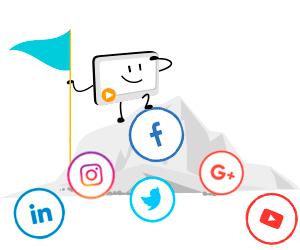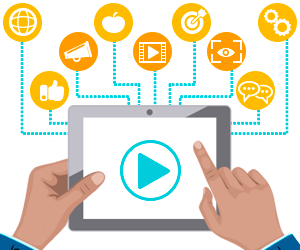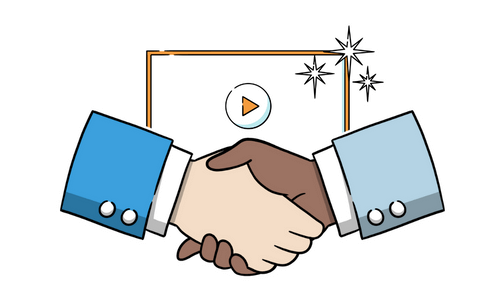5 effective tips on how to use video for B2B sales
Videos have already become an essential part of our life along with texts and images. They can be used not only for entertainment purposes but they can also be an effective tool for boosting sales, employee training, and for explaining any complex topic! The following tips will show you how to turn video into a powerful marketing tool to increase your B2B sales.
Be original but consistent
Social media provides broad opportunities for sharing content. There is the temptation to use a funny picture or a video that has been produced by another person, for your aims. However, what has already been seen, does not make such a strong impression as original and newly created content.

Do not try to copy anyone or make your content in someone’s style. Just be yourself and think of the most appropriate ways of delivering your message to the customers. What effect do you want to have on them? What do you want them to do after watching your video? You know your aims best of all and you determine how you will be achieving them. The originality of your content grabs customer attention, makes them watch your video and what is most important, makes them remember the message.
Along with that, you should not expect that only one video message will have the desired effect. The overwhelm of information in customers’ heads can be too high to allow your message to be clearly perceived and understood. A series of videos that present and explain your message from different perspectives will be more effective. Each following video will remind your customer about you and your product and will increase the chances of a purchase.
Make the information clear for your customers and explain the benefits they will receive
The distinction of B2B products from B2C ones is that the latter are destined for end customers and are comparatively simple. The former are normally complex products whose efficiency may not be evident. A decision-maker on the customer side may not be aware of the profit or benefits brought by your product or service.

Since your B2B product is likely a complex decision or service with a lot of technical details and characteristics, the effects might be difficult to grasp even by professionals in the same or an adjacent sphere. They do not have to know the product as deeply as you, but they will inquire why they should buy it.
Therefore, you aim to explain this in simple words. Why should a company use your product? What positive effects will it bring to your customer’s business? Is cost reduction, an increase in efficiency or profitability growth? How will it make the life of their customers easier?
A video format allows you not only to describe but also demonstrate the advantages of your product. B2B purchases are mostly rational rather than emotional, so your video should provide pragmatical arguments in favour of your product.
Use the entire potential of video content
Video is a versatile medium in which information can be presented in different ways. These include a whiteboard, stop-motion, animation, live-action, dynamic infographics, video description, interviews with relevant people, humour, representation of calculations etc. In fact, video combines the advantages of other formats and adds some specific benefits that no other format has.

Accordingly, you can achieve different aims using video. Introduce new products and services, attract customer attention through visual effects, explain the differences between new and existing products or between your products and those of competitors. Show the figures that will confirm your declarations, present the benefits of using your products in numbers and understandable indicators, and provide feedback of users who have already purchased a product.
Visual presentation is the one that has the strongest effect on the organs of perception. It grabs customer attention more efficiently than text or images and thus increases the conversion rates of your message. When you use video for a narrow range of functions and ignore most of its advantages, you can still attain your goals, but you will be less effective.
Reverse storytelling
Storytelling can be a powerful marketing tool since it captures customer attention and is perceived better than a chaotic array of information. We all love stories, and we always want an interesting story to be told to the end. However, marketing video content works according to different rules.

While a story implies that the listener’s attention should be captured as long as possible and the culmination will happen in the end, customers will unlikely watch a video that has not attracted them from the very beginning. They will merely not wait until the end!
Their impression of the video and their willingness to continue watching is formed in the first 3-5 seconds. This means that you should grab their attention in this short period and give the most important information in the beginning. Once you have captured customer attention, you can provide details, explain and enhance the created impression.
The stage of the funnel determines the format
A video can be produced for different aims. One of the crucial factors affecting the content is the customer’s action you want to encourage. Different levels of the sales funnel require different content especially in B2B sales.

Informing and increasing the awareness of businesses and customers who are only getting acquainted with your product is the initial stage of the funnel. Here, you describe and broadly present the product. Meanwhile, when a customer is already familiar with your product and you want to push them to purchase it, your message should be more active and urging.
Also, keep in mind that B2B sales are often coordinated and negotiated at different levels. A specialist’s focus is on the exploitation and ways of working with this product. A manager’s focus is on the technical and economic effects that a product may bring to their organisation. So, use different types of video with different messages to deliver the required information. The clearer you explain to each customer, the higher the chance of product purchase.
Final thoughts on video for B2B sales
The benefits of video marketing are extremely compelling however when working in B2B sales, different goals and aims need to be addressed. Clearly, when marketing to businesses you need to convey much more detail and specifics in order to convince them to purchase your product or service. Video marketing can be the answer to all of their questions.
Allowing your business to demonstrate, explain, and declare its benefits to potential customers. Therefore, using video in the right ways as mentioned above can be the next best move for your business to increase conversions and improve your B2B sales.
Author Bio

Anna Clarke is the owner of the online essay writing service 15 Writers. She is a successful entrepreneur with over 20 years of experience in freelancing and consulting, specialising in Business, Economics, Finance, Marketing and Management.
